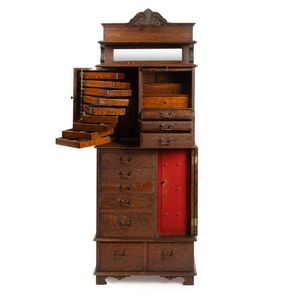Antique Dentist Cabinet by American Cabinet Co
You must be a subscriber, and be logged in to view price and dealer details.
Subscribe Now to view actual auction price for this item
When you subscribe, you have the option of setting the currency in which to display prices to $Au, $US, $NZ or Stg.
- Maple - Maple, native to North America, is a dense heavy timber from light to yellow-brown in colour. It has very little distincive graining unless it is one of the variants such as birds-eye maple or burr maple, so was not used extensively for furniture in 18th and 19th century, where cabinetmakers and designers preferred timbers with more distinctive features such as mahogany, walnut, rosewood and oak.
Birds-eye maple has a seres of small spots linked by undulating lines in the grain, is highly sough and is used as a decorative veneer. Burr maple has larger and irregular grain swirls than birds-eye maple. - Oak - Native to Europe and England, oak has been used for joinery, furniture and building since the beginning of the medieval civilisation. It is a pale yellow in colour when freshly cut and darkens with age to a mid brown colour.
Oak as a furniture timber was superceded by walnut in the 17th century, and in the 18th century by mahogany,
Semi-fossilised bog oak is black in colour, and is found in peat bogs where the trees have fallen and been preserved from decay by the bog. It is used for jewellery and small carved trinkets.
Pollard oak is taken from an oak that has been regularly pollarded, that is the upper branches have been removed at the top of the trunk, result that new branches would appear, and over time the top would become ball-like. . When harvested and sawn, the timber displays a continuous surface of knotty circles. The timber was scarce and expensive and was used in more expensive pieces of furniture in the Regency and Victorian periods. - Secondary Timbers - As indicated by the name, these are less expensive and thus lower quality timbers used in the construction of an item in surface areas that may not generally be seen, such as backboards, or as the ground for veneers, drawer linings or for framing.
This item has been included into following indexes:
-
cabinets, material
- oak 563
- pine and kauri pine 139
- dental / dentist's furniture and equipment 29
- Maple & Co. (London, England) - furniture, designers and makers 20
Visually similar items

A maple blanket box with brass handles 5s x 90 x 56 cm

An Australian Arts & Crafts carved oak box, the hinged top carved with gumnuts and leaves, the front carved with two owls on a branch with gumnuts and the carrying handles on either side carved with gumnuts and leaves, raised on later bun feet, with plain

Antique walnut and brass bound writing slope with interior fittings and secret lower drawer on left hand side, width 45 cm x depth 26 cm x height 19 cm

Vintage Oshkosh fitted travelling trunk
